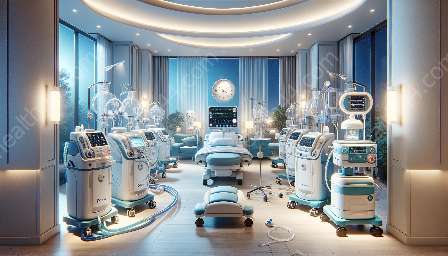Oxygen concentrators play a crucial role in providing essential respiratory care and are an integral part of medical devices and equipment. In this comprehensive guide, we will delve into how oxygen concentrators work, their significance in respiratory care, and their role in medical devices & equipment.
The Basics of Oxygen Concentrators
Oxygen concentrators are medical devices that deliver oxygen to individuals with breathing difficulties or low oxygen levels. They are commonly used in healthcare settings, as well as in home environments, to ensure that patients receive an adequate supply of oxygen.
These devices work by drawing in air from the surrounding environment and then removing nitrogen to provide a concentrated flow of oxygen to the patient. The oxygen is delivered through a nasal cannula or mask, allowing the individual to breathe more easily and effectively.
Oxygen concentrators are particularly beneficial for individuals with chronic respiratory conditions, such as chronic obstructive pulmonary disease (COPD), emphysema, and pulmonary fibrosis. They help alleviate symptoms such as shortness of breath, fatigue, and dizziness, and can improve overall quality of life for patients.
Importance in Respiratory Care
Oxygen concentrators are integral to respiratory care, as they are crucial for managing and treating various respiratory conditions. By delivering a continuous and reliable supply of oxygen, these devices support patients in maintaining adequate oxygen saturation levels in their blood.
In addition to providing relief from symptoms, oxygen concentrators also aid in preventing complications related to low oxygen levels, such as organ damage and cognitive impairment. They are essential for enhancing the comfort and well-being of individuals with respiratory disorders and are often prescribed as part of a comprehensive respiratory care plan.
Furthermore, oxygen concentrators play a vital role in respiratory therapy and rehabilitation programs. They enable patients to engage in physical activities and exercise while receiving the necessary oxygen support, promoting better pulmonary function and overall respiratory health.
Integration with Medical Devices & Equipment
As medical devices, oxygen concentrators are designed to seamlessly integrate with other respiratory care devices and medical equipment. They are often used in conjunction with devices such as ventilators, CPAP (continuous positive airway pressure) machines, and nebulizers to provide comprehensive respiratory support.
For individuals with severe respiratory conditions, oxygen concentrators can be combined with portable oxygen cylinders or liquid oxygen systems to ensure continuous oxygen availability, especially during travel or mobility outside the home environment.
Moreover, oxygen concentrators contribute to the overall ecosystem of medical devices and equipment by serving as a fundamental component of respiratory care infrastructure. Their compatibility with various devices enhances the flexibility and effectiveness of treatment regimens for patients with diverse respiratory needs.
Advancements in Oxygen Concentrator Technology
Over the years, advancements in technology have led to significant improvements in oxygen concentrator design, performance, and portability. Modern oxygen concentrators are more efficient, quieter, and highly portable, offering greater convenience and mobility for patients requiring oxygen therapy.
Some models feature compact and lightweight designs, allowing patients to carry them easily and engage in daily activities without restrictions. Additionally, advanced features such as adjustable oxygen flow rates, user-friendly interfaces, and long-lasting battery life have enhanced overall user experience and adherence to therapy.
Furthermore, the integration of smart connectivity and monitoring capabilities in certain oxygen concentrator models enables healthcare providers to remotely monitor patient usage, adjust settings as needed, and ensure optimal therapy management and patient compliance.
Conclusion
Oxygen concentrators are indispensable in the realm of respiratory care and medical devices & equipment. Their ability to provide consistent and reliable oxygen supply, seamless integration with other devices, and technological advancements have transformed the landscape of respiratory therapy and improved the quality of life for patients with respiratory conditions.
By understanding the crucial role of oxygen concentrators and their compatibility with respiratory care devices and medical equipment, healthcare professionals and individuals alike can appreciate the significance of these devices in supporting respiratory health and well-being.


